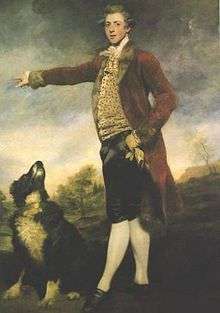John Campbell, 1st Baron Cawdor
| The Right Honourable The Lord Cawdor FRS | |
|---|---|
 Portrait by Sir Joshua Reynolds | |
| Member of Parliament for Cardigan Boroughs | |
|
In office 1780–1796 | |
| Member of Parliament for Nairnshire | |
|
In office 1777–1780 | |
| Personal details | |
| Born |
1753 Great Britain |
| Died |
1 June 1821 (aged 68) Bath, Somerset, UK |
| Resting place | Bath Abbey |
| Political party | Pittite (from 1783) |
| Other political affiliations | Whig (until 1783) |
| Spouse(s) | Isabella Caroline Howard |
| Children | 2 |
| Education | Eton College |
| Alma mater | Clare College, Cambridge |
John Campbell, 1st Baron Cawdor, FRS (ca. 1753 – 1 June 1821), was a British politician, army officer and art-collector.
Biography
John Campbell was born ca. 1753, the son of Pryse Campbell of Stackpole Court, Pembrokeshire, and Sarah (née Bacon). His siblings were Sarah, George, Alexander and Charles Campbell. He was sent to board at Eton College, Berkshire (1763–67). Afterwards he studied at Cambridge University (Clare College) (1772).
His father died in 1768, so when his grandfather died in 1777 John inherited Stackpole Court and his grandfather's estates in Pembrokeshire and Nairn, and a mineral-producing estate in Cardiganshire; these lands and mines made him a rich man. From 1777 to 1780 he was Member of Parliament for Nairnshire. He became Member of Parliament for Cardigan Boroughs from a by-election in June 1780 until he stood down at the British general election, 1796.[1][2] From 1780 he was Governor of Milford Haven.
Between 1783 and 1788 Campbell visited Italy and Sicily, where he bought antiquities from Fr. John Thorpe, Henry Tresham, James Durno and Thomas Jenkins, commissioned paintings of archaeological sites in Naples and Sicily from Xavier della Gatta, Tito Lusieri, Henry Tresham and Louis Ducros, and bought sculptures from the young Canova, but he never received them.[3] In 1788 Campbell bought from Giovanni Volpato the celebrated Lante Vase [now at Woburn Abbey, Bedfordshire]. He also began a collection of 'Etruscan' (i.e. ancient Greek) vases from Nola and other southern Italian sites, and had further examples sent to him after his return to Britain, including the 'Campbell Crater' excavated at Lecce in 1790. He also continued to acquire architectural and sculptural fragments and casts. Campbell established a Museum in his house in Oxford Street, London, which had an art-historical rather than decorative intention, and was hailed by the sculptor, John Flaxman, as 'excellent news for the arts'.[4]
In 1789 on 28 July John Campbell married Isabella Caroline Howard - daughter of Frederick Howard, 5th Earl of Carlisle and Margaret Caroline Leveson-Gower. They had two children:
- John Frederick Campbell, 1st Earl Cawdor (1790–1860), married Elizabeth Thynne, daughter of 2nd marquis of Bath
- Rear-Admiral Hon. George Pryse Campbell (1793–12 August 1858), married on 13 October 1821 Charlotte Gascoyne, daughter of Isaac Gascoyne.
In 1794 Campbell became a Fellow of the Society of Antiquaries, and in 1795 a Fellow of the Royal Society.
As a Parliamentarian, Campbell was at first a Whig and a supporter of Lord North. In debates on the North Atlantic slave trade he supported the abolitionists. He became a supporter of the younger Pitt's war policy. On 21 June 1796 Campbell was made a peer with the title of 'Baron Cawdor' of Castlemartin in the County of Pembroke. As a landowner he was an active improver - draining the Castlemartin Corse and creating Bosherton lakes. His generosity to the poor was proverbial.
In 1797 he was the commander of the Pembrokeshire Yeomanry, who defeated Napoleon's troops in the Last invasion of Britain.[5]
In 1800 Campbell sold the contents of his Museum. Several items were sold to the architect, Sir John Soane.
In 1804 Campbell added to his extensive land-holdings by inheriting John Vaughan's estates at Golden Grove, Carmarthenshire. In 1808 he was mayor of Carmarthen.
Campbell died on 1 June 1821, at Bath. He is buried at Bath Abbey.
A portrait of John Campbell was made by Joshua Reynolds (1778; now in Cawdor Castle, Nairn); a miniature of him by Richard Cosway is in the National Galleries of Scotland.
Further reading
- I. Bignamini, C. Hornsby, Digging And Dealing In Eighteenth-Century Rome (2010. Yale U.P.), p. 249-251
- A Dictionary of British and Irish Travellers in Italy, 1701-1800, Compiled from the Brinsley Ford Archive by John Ingamells (1997)
- F. Russell, 'A Distinguished Generation: the Cawdor Collection', in Country Life; (14 June 1984), p. 1746-1748
- E. H. Stuart-Jones, The Last Invasion of Britain (1950)
References
- ↑ Leigh Rayment's Historical List of MPs – Constituencies beginning with "C" (part 2)
- ↑ Stooks Smith, Henry. (1973) [1844-1850]. Craig, F. W. S., ed. The Parliaments of England (2nd ed.). Chichester: Parliamentary Research Services. p. 589. ISBN 0-900178-13-2.
- ↑ H. Honour, 'Canova's 'Amorini' for John Campbell and John David Latouche', in Antologia di belle arti; 48/51 (1994), p.129-139.
- ↑ W. G. Constable, John Flaxman, 1755-1826 (1927), p.33-34.
- ↑ E. H. Stuart-Jones, The Last Invasion of Britain (1950)
| Parliament of Great Britain | ||
|---|---|---|
| Preceded by Cosmo Gordon |
Member of Parliament for Nairnshire 1777 – 1780 |
Succeeded by Alexander Campbell |
| Preceded by Thomas Johnes |
Member of Parliament for Cardigan Boroughs 1780 – 1796 |
Succeeded by Hon. John Vaughan |
| Peerage of Great Britain | ||
| New creation | Baron Cawdor 1796–1821 |
Succeeded by John Frederick Campbell |